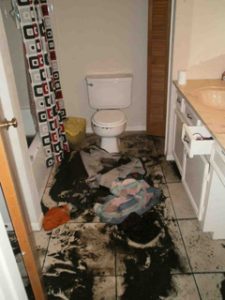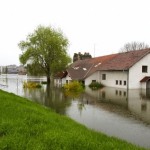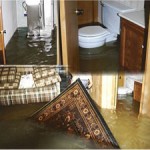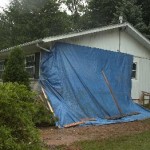
When your toilet overflows, it can spur incredible angst and anxiety. Your eyes glaze over as you watch the water slowly fill to the rim then spill over the top onto your bathroom floor. A toilet overflow can be dreadful, especially if it is a recurring problem.
Several factors can cause an overflowing toilet:
- A clogged drain line may at times be the reason a toilet overflows. A water line that connects to the washing machine, for instance, may be clogged, leading to the clog to the septic tank or sewage system.
- The water lines connecting to the sewer system in your home may be blocked or dislocated due to tree roots. Or, if your home features a septic tank, it may be too full to absorb any additional water.
- The trap at the back of the toilet may be blocked with too much toilet paper, kids’ toys or foreign objects. Water is prevented from draining when this S-shaped trap is blocked.
- Some homes feature a low flow toilet. These older, weaker toilets were likely to have been manufactured between 1994 and 1997. Certain non-flushable items or too much toilet paper can disrupt the drainage in a low flow toilet, leading to a nasty backup and subsequent overflow.
When the water in your toilet dangerously reaches the rim, it’s necessary to take immediate steps to prevent an overflow.
1. Turn off the water supply and stop flushing

If the toilet is still flushing, don’t flush it again. This can make the situation worse and cause more water to overflow. The first step is to prevent more water from entering the bowl by turning off the water supply. Remove the lid off the toilet tank and depress the flapper so additional water does not fill the toilet bowl. Locate the water supply off switch at the bottom of the toilet or behind it. If you do not see a valve to shut off the water supply, turn off the water supply to your home. You can locate the water supply line in the basement, in close proximity to the water heater. Typically, turning the water lines via the valve or knob in the basement will stop the flow of water if it is due to a clog instead of a sewer backup.
2. Plunge
Before you tackle this next step, stay hygienic by putting on a pair of long rubber gloves or disposable gloves to protect yourself from harmful bacteria.
Once the water has stopped flowing into the toilet, empty out as much water as necessary to start plunging without causing additional overflow. Use a bucket to clear out the water into a nearby sink, if it’s clean, and into another bucket if the water is dirty. You will pour the dirty water back into the toilet bowl for safe disposal once it is unclogged.
Grab the nearest toilet bowl plunger to plunge the drain. Be careful to align the tip of the rubber plunger to the center of the drain in the toilet bowl. Start by plunging slowly, then gradually with more speed. Any clogs that blocked the toilet drain will eventually be dislodged, and the water in your toilet will drain fully.
3. Twist with a Snake

If the plunger fails to work, use a snake, also called an auger. You can find an auger at a local hardware store, typically costing around twenty to fifty dollars. Put the spring end of the snake into the toilet drain and twist until the auger has penetrated into the blockage. The snake will loosen the blockage. At this point, you should flush the toilet to see if the toilet drains properly. If not, repeat the process using the snake to dislodge any remaining obstructions.
4.Clean Up Excess Water
If there’s water on the floor, use towels or a mop to clean it up. It’s essential to dry the area to prevent slipping and minimize water damage.
5. Fix the Flushing
The flushing mechanism on your toilet may at times be out of sync, causing it to overflow. This problem is easily fixed by lowering the toilet’s flushing floater, which can be a rubber ball in older toilets and a column-like floater in newer models. Access the flushing floater by removing the lid to the toilet tank. You’ll notice a small clip-like device that controls the floater’s height. Adjust this clip so that the floater rests lower in the water. Flush the toilet to see if it resumes flushing functionally. If the water overflow does not resolve, repeat the steps to gradually continue to lower the flushing floater further down.
6. Call a Professional
If the toilet overflow persists, it may be necessary to call a plumber. A professional will use an industrial auger, which can stretch to over 100 feet. The steel cables in this type of auger can reach far enough into the main sewage line to dislodge the clog.

An overflowing toilet can cause severe water damage to your home. Dirty water overflowing from the toilet may contaminate parts of your home, leaving it unsanitary and uninhabitable. Not only is bacteria released into your home via the toilet overflow, but water damage is an inevitable result of the overflow as well. Porous surfaces, like drywall, insulation and the property’s wooden structures, are weakened through the absorption of water, making your home vulnerable to additional significant damage.
Sewage Cleanup Services
Sewage contamination can be quickly handled by a sewage cleanup company. These cleanup professionals work quickly to remove excess water from your home. Skilled technicians use advanced water extraction equipment to drain moisture from structural elements, furnishings and other affected belongings. Water damage experts also restores affected contents in the event these items are affected by water damage. Specialists take steps to thoroughly clean upholstery, rugs, carpets and the building’s contents to ensure they are sanitary and can remain in your home.
As soon as water floods your home, whether through a toilet overflow or flooding from another source, it is important to call a water damage restoration service as soon as possible. Taking swift steps protects your home from the rapid growth of mold, which is a direct result of excess moisture in your home. i




